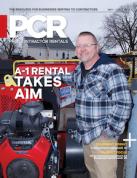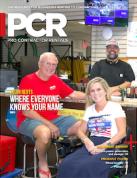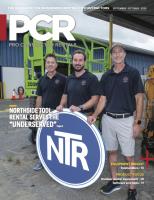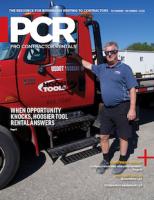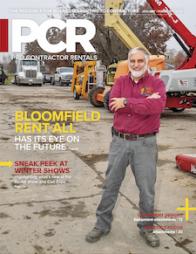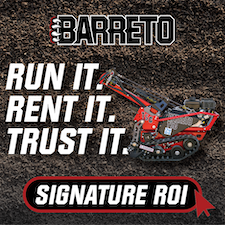Industry Outlook -- Skid steer and compact track loaders
Skid steers and compact track loaders are transforming into machine lines that can be matched to jobs, increasing job site efficiency and productivity.
After nearly seven decades since the introduction of the first skid steer loader, new models sport more power, versatility and reliability.
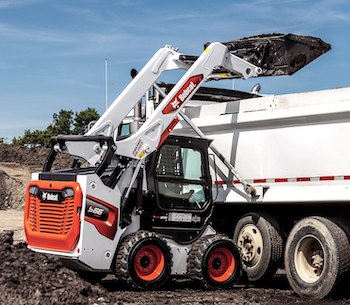 |
| When considering adding a new machine to a fleet, rental centers need to look at fleet utilization. Typically, rental yards want equipment at 70 percent utilization, but when they see regular, higher utilization, this is an indication that additional machines are needed |
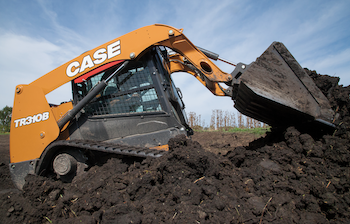 |
| For a rental house, having access to telematics data and setting notifications if machines operate outside of operational parameters is critical. It can inform the renter of problems and cue them to contact the rental house for assistance. |
Pro Contractor Rentals asked skid steer loader (SSL) and compact track loader (CTL) experts about advances in these models, considerations that rental centers must ponder as they update their rental fleet and how can rental centers improve their ROI with these units.
Brady Seavert,Director, National Accounts and Government Sales
Josh Hegle, National Accounts Manager
Jason Pike, Senior Key Account Manager
Doosan Bobcat
Telematics and attachments add rental value
Bobcat is driving innovation in its telematics platform to help customers fully understand equipment from multiple perspectives – as an owner/operator, a rental center owner, a service technician or as dealer.
This enhanced focus on telematics allows everyone involved in the use and maintenance of the machine to be more efficient and gain a better understanding of the equipment.
The Bobcat Machine IQ telematics system provides information such as hours in use, fuel level, equipment location and service milestones. Customers can also add on subscription options for critical fault-code notifications, setting up geofences and machine curfews. This also allows Bobcat dealers to proactively reach out to customwers about alerts or service needs.
Security features benefit rental centers. New Bobcat R-Series loaders offer keyless entry ands unique operator codes generated for each rental customer. Because rental houses cater to a number of different customers with a wide range of experience, Bobcat has added machine features that support a wide range of operator skill levels. The hand control allows an owner to dial down travel speed, as well as control sensitivity, without sacrificing productivity or efficiency. Bobcat, also provides QR code decals in equipment so operators can watch instructional videos on their cell phones.
When considering adding a new machine to a fleet, rental centers need to look at fleet utilization. Typically, rental yards want equipment at 70 percent utilization, but when they see regular, higher utilization, this is an indication that additional machines are needed.
We also encourage rental centers to consider what they are hearing from their customers. A new machine should incorporate the features and benefits that help customers solve job site challenges, including topography and weather considerations.
For rental centers looking to build out their skid steer and compact track loader lineup from scratch, they should research local competition to understand what equipment customers can access at other centers. This can help identify the machines and attachments that will provide a competitive edge.
From an expense perspective, rental centers need to determine a comfortable cost of ownership budget. For example, tracks are more expensive to maintain, but can allow customers to work in different conditions than a skid steer loader. However, for extensive material removal, a skid steer is ideal for efficiency and productivity. Consider how the machine will be used, what the machine needs to accomplish and market it accodingly.
To increase functionality of a piece of equipment, there are fewer options more cost-effective than a robust suite of attachments. Bobcat, for example, offers more than 100 different attachment options – the most of any OEM – to address all aspects of a job site. A rental center with the right attachment options will attract more customers and increase the equipment utilization.
Another big impact on ROI is understanding a machine’s life cycle. Rental centers should look at up-front acquisition costs but also understand the ideal time to sell a unit. Customers will want to try newer, updated equipment, so understanding the right time to swap out machines is critical.
Rental center managers need to focus on marketing and promotion. This includes understanding how to drive product demand and engaging with customers to better understand their opportunities and challenges. Taking the time for this research helps build a loyal customer base and right-sizing your equipment fleet.
We encourage rental centers to build a good relationship with their local dealer partners. A quality dealership can provide service and support to help the owner stay on top of proactive maintenance, provide utilization and customer insights and educate rental centers on all aspects of the attachments and equipment.
 |
|
David Garton |
Grade control gains popularity
Skid steers and CTLs have come a long way in a short time. We’re seeing multi-function LCD displays, easily adjustable electro-hydraulic controls, switchable operating patterns, premium comfort features in the cabs – all of this amounts to a simpler, more ergonomic operating experience.
Machine/grade control is becoming more accepted by end users and rental companies are starting to make it available to customers.
Telematics are also being utilized more and more by rental companies. For a rental house, having access to telematics data and setting notifications if machines operate outside of operational parameters is critical. It can inform the renter of problems and cue them to contact the rental house for assistance. Before telematics, an operator may just keep operating the machine because he or she didn’t understand a fault code and made the problem worse by continuing to operate the unit. Telematics helps prevent that from happening by providing immediate notification.
A rental house can check the health, placement and condition of their equipment while it’s out with the customer in real time.
When it comes to adding new machines to a rental fleet, rental centers must calculate the rental rate and its return on asset, which is more than just the purchase price of the machine. If one brand has an advantage – it may be something as simple as one brand’s oil change interval is 500 hours, and another brand’s is 2,000 hours – if you extrapolate that over the duration of ownership, those savings really start to add up.
Ultimately, those costs have to roll up into a profitable rental rate. That rate should also consider taxes, depreciation and retail value, auction value and other factors.
When it comes to selecting the new models, it’s important to know what’s available in your territory from competitors while understanding what your customers want.
A small to mid-size rental store has the opportunity to ask customers, “What works best? How high of a truck are you loading?” then, figure the correct rental rate. Think about what’s coming down in the future, not just what customers need today.
When it comes to a rental machine, depending on the job, the customer just wants to dig a hole. On long-term rentals, however, the salesperson needs to can gain customer credibility and loyalty. If the rental person can point out a feature or practice on your machine that will save the customer time and money, whether it’s putting a machine in economy mode and it still meets the needs of an application, or providing a tip to help them reduce fuel usage, a customer will put more faith in your recommendations and trust you and your equipment.
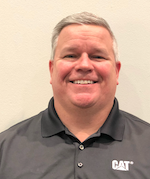 |
|
Kevin Coleman |
Smart models improve versatility, usability
The key considerations for rental centers are equipment maintenance/repair costs, ease of use and fleet utilization, especially with today’s machines being rented with a growing variety of attachments.
The ease of equipment maintenance and being able to turn a machine around from one rental to another is a key factor. Machines that are designed for ease of service deliver high value for rental centers and customers. An integrated in-cab display with rear-view camera allows the operator to avoid potential damage with better job site visibility.
Customers want equipment that help make operation easier and more productive while helping a novice turn into a skilled operator.
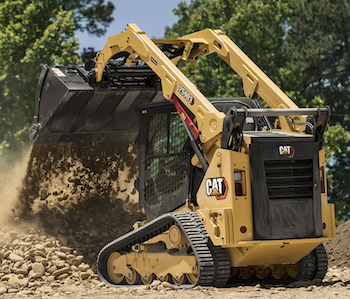 |
| Labor-saving features such as dual-direction self-leveling, return-to-dig feature, and work-tool positioning have been available on Cat skid steer loader and compact track loader models since 2013. |
Features that help customers save time and/or make more money by automating repetitive tasks such as grading, digging are gaining interest. Labor-saving features such as dual-direction self-leveling, return-to-dig feature, and work-tool positioning have been available on Cat skid steer loader and compact track loader models since 2013.
Equipment versatility drives fleet utilization and a multitude of attachments can be used with a skid steer or compact track loader.
The creep feature can help maximize the versatility, productivity and control of attachments. Creep allows an operator to set travel speed to match the attachment, machine hydraulics and ground/operating conditions. To take versatility to the next level, Cat D3 Series SSL and CTL models come standard with the new Smart Technology that integrates the machine and a line of new Smart Attachments that include the Smart Backhoe, Smart Grader Blade with Assist, and Smart Dozer Blade with Assist. This industry-first machine technology recognizes the Smart Attachments and tailors the joystick controls and in-cab operator information to match the tool and the task.
Selecting the right size of machines, type, and how to equip them can be a challenge. Should the units be small-, medium-, or large-frame? Standard auxiliary flow or high flow? Rubber tire skid steer or rubber track compact track loader? Enclosed cab or open canopy? Each of the decisions can afectROI via the acquisition cost, maintenance costs, rental rates and the compatible attachments that can be rented with the machines.
In some areas, the focus is on small to mid-size skid steers and compact track loaders. The mid-sized rubber tire and rubber track loaders are popular with rental customers due to the high performance in relatively compact chassis size. This size is also easy to transport and can maneuver on tight job sites. They can be paired with many attachments that offer excellent asset utilization and potentially more revenue.
In other regions, fleet utilization is increased with larger machines in the fleet for handling larger loads or for operating large, high production hydro-mechanical attachments such as brush cutting or mulching. Consider these options before deciding what machine type, size, and features best suits your business.
Rental centers are recognizing the value that the track machine provides vs. a comparable sized skid steer. Compact track loaders offer higher rated operating capacity, more stability, lower ground pressure, less ground disturbance and a broad range of application capabilities over a rubber-tire skid steer. Cat compact track loaders are well suited for a rental where it is difficult to control the application, material, maintenance and operating technique of rental customers. The durable steel-embedded track as well as steel undercarriage components offer maximum life for rental centers. They also feature a standard torsion suspension undercarriage that helps provide longer track life, improved traction, increased operator comfort and better material retention.
 |
|
Alex Berg |
Mini skid steers continue to evolve
In 1957, two brothers living in Minnesota disrupted the construction industry with their invention of the first compact loader. The brothers owned a small manufacturing and fabricating business and were known for their inventive prowess. A local farmer sought their help to build a machine that could improve his turkey farm’s efficiency. Fast-forward 64 years, and the mini skid steer is still changing the game.
Seven years ago, Cratos Equipment was created to provide a solution for safely working indoors. At the time, while working inside the Fort Lauderdale airport, we were on a job site with no shortage of restrictions. Our company found the battery-powered Sherpa mini skid steer that answered thoe restrictions. Years later, we’ve listened to our customers and made the Sherpa even safer and more efficient.
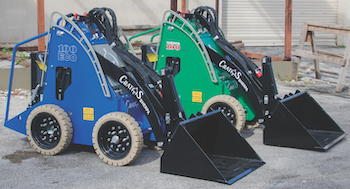 |
| In 2020, Cratos introduced an upgraded Sherpa 100ECO and the all-new Sherpa 2Speed, bringing significant changes and improvements to the battery-powered skid steer. |
In 2020, Cratos introduced an upgraded Sherpa 100ECO and the all-new Sherpa 2Speed, bringing significant changes and improvements to the battery-powered skid steer.
The Sherpa 100ECO model now has no-drip fittings mounted to a fixed location, a larger foot pedal area, and two additional anchor points.
For many years, the Sherpa mini skid steer has been synonymous with job site safety because it reduces the need for backbreaking work, emits no toxic fumes, and because of its minimal noise allows ease of job site communication. Safety will continue to be a top priority for Cratos Equipment and the Sherpa Skid Steer.
In the first quarter of 2020, Cratos announced a new Li-ion battery for both models. Cratos leveraged the latest advances in battery technology that achieves the highest possible power density for these machines. The Li-ion battery can be recharged hundreds of times, even when not fully discharged, offers greater stability and a longer run time.
The Li-ion battery on the Sherpa mini skid steer yields approximately 10 hours of work and can be charged with a 110- or a 220-volt outlet.
Customers always want faster and stronger machines and the Sherpa 2Speed delivers that by pushing harder and driving faster all in the same compact size as the Sherpa 100ECO. At low speed, it has increased torque and can turn on a dime. In high speed, while torque is reduced, the higher hydraulic flow allows the operator to travel longer distances faster.
Cratos Equipment has a steadfast focus on innovation and technology. Customers’ needs are always changing, and Cratos wants to make sure it can provide them with exactly what they need to make their job site more efficient, safer and ultimately more profitable.
 |
|
Brant Kukuk |
Stand-on skid steers gaining popularity
Stand-on skid steers have historically been used as loaders, but they are increasingly being used for a wider array of jobs as they become more powerful, simpler to operate and more versatile.
For example, larger machines, such as the Ditch Witch SK3000, complete jobs that were once done with only traditional cabbed skid steers on landscaping, tree care and construction jobs. The larger stand-on skid steers are designed with low ground pressure and a compact frame so that they can maneuver in space-restricted urban areas without damaging a job site. With the growing number of attachments, stand-on skid steers are taking on tasks that can be very labor-intensive or traditionally done with attachments on larger units.
Stand-on skid steers can take on a variety of different jobs, so rental yards have a wide-open market. They can be a one-machine solution for customers. For example, a new home needs sitework, retaining walls, utility installation, landscaping and hardscaping; a stand-on skid steer can accomplish these tasks simply by switching attachments.
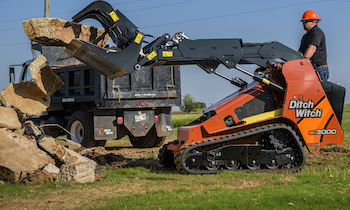 |
| Because stand-on skid steers are versatile machines, they already have a high ROI and demand is currently high. Simply having a stand-on skid steer on your lot will attract renters. |
While these machines are extremely versatile and won’t sit on the lot long, they can have a higher package cost due to their attachments, trailer package and machine weight. Rental yards need to understand this before investing in stand-on skid steers. The potential higher upfront cost, vs. a walk-behind trencher, for example, should be considered, but they have very strong ROI.
Because stand-on skid steers are versatile machines, they already have a high ROI and demand is currently high. Simply having a stand-on skid steer on your lot will attract renters. However, for rental centers that are looking to further improve their ROI, investing in attachments is a good avenue to take. By adding attachment options to the rental fleet, a rental center can open new markets and customer bases. For example, stand-on skid steers can be equipped with a bucket, pallet forks, trencher, auger or plow, among others.
 |
|
Kent Marshall |
Simpler units improve ROI
When it comes to rental equipment operation, the simpler the machine, the better. Ease of operation and comfort are key influencers that drive customer demand for rental yards catering to weekend warriors.
Manufacturers are taking note of those preferences. Manitou Group is shifting the design of compact loaders from conventional controls, such as hand-and-foot, to joystick operation for ease of use. This transition is more intuitive for novice operators because they are familiar with these controls on other devices, including the gaming industry. The more comfortable an operator feels in the cab, the more likely they are to rent a machine for a DIY project at home.
Advances in telematics are being used in the rental industry. Gehl’s Connected Machines solution by Manitou helps rental centers track the machine location,number of hours for maintenance and allows remote troubleshooting.
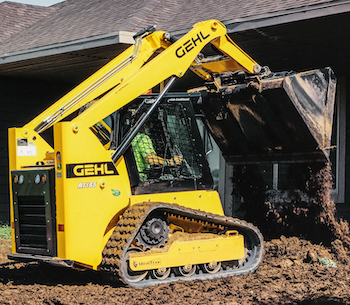 |
| When it comes to rental equipment operation, the simpler the machine, the better. Ease of operation and comfort are key influencers that drive customer demand for rental yards catering to weekend warriors. |
Ease of transporting skid and compact track loaders is important. Smaller units make for lighter machines, for instance, the Gehl RT105, RT135 and RT165 track loaders, which can easily be towed on a trailer by a renter. This can increase demand for portable units as renters do not have to depend on someone delivering the machine for them. Some rental centers now place these compact units on trailers ahead of time, which offers peace of mind that the equipment is properly placed for safe transportation.
Rental machines that offer fewer features reduce the possibility of damage from renters/users. It also keeps acquisition cost lower.
Main necessities are open ROPS configurations depending upon the geographic area, joystick controls, standard-flow hydraulics and a manual quick-attach device for attachments. This differs from an owner-operator, who purchases equipment they will customize for everyday use.
Open-ROPS machines will not incur as many expenses as an enclosed cab units with glass, heat and air conditioning, high-flow hydraulics and 14-pin connectors. Rental machines offer minimal repair costs and fewer options to replace, particularly when it comes to broken glass doors and windows. This improves overall ROI with a lower cost of acquisition, and decreases maintenance costs resulting in lower TCO.
With TCO being paramount, Gehl track loaders are designed with the patented IdealTrax system to decrease overall track maintenance and repair. IdealTrax automatically tensions the tracks from start up to shut down, increasing the overall track life for more machine uptime and improved ROI for the rental center.
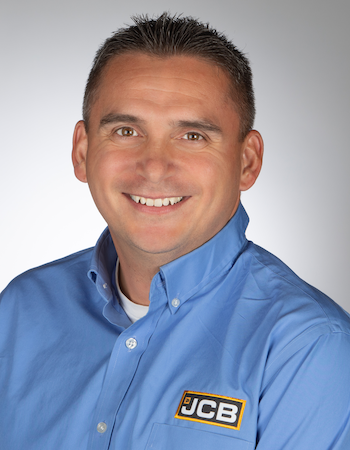 |
|
Chris Trampush |
Design advances, attach-ments improve ROI
Compact skid steers and compact track loaders are highly efficient workhorses equipped for a wide variety of job applications. Instead of needing two or three machines, these multitaskers can handle interior and exterior demolition, road building, maintenance projects and clearing snow and debris.
Because these compact machines offer such exceptional versatility while still providing outstanding power and performance, they are ideal machines for a rental fleet. JCB is constantly developing ways to improve JCB skid steers and compact track loaders, taking into consideration the needs of our customers. TheJCB design team is constantly working on features to provide additional safety – which is always our primary goal – as well as operator comfort, visibility, and efficiency.
With the launch of the JCB Teleskid, it is the only model in this class with a telescoping boom, allowing it to lift higher, reach farther and dig deeper than any other skid steer. This allows for more efficient applications in construction, agriculture, and landscaping.
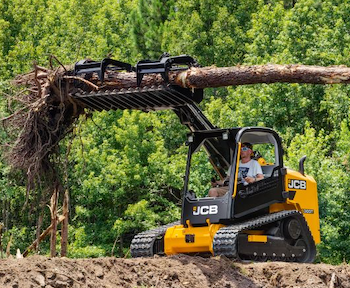 |
| With the launch of the JCB Teleskid, it is the only model in this class with a telescoping boom, allowing it to lift higher, reach farther and dig deeper than any other skid steer. This allows for more efficient applications in construction, agriculture, and landscaping. |
The advantage of providing new machines in a rental fleet is exceptional customer satisfaction. New models offer operators access to a more comfortable ride and a safer, more efficient machine. There are cost savings as well; fuel costs are lower and servicing is easier.
Providing new machines means an upfront cost increase for a rental feet owner, but in the long run, there will be an increase in ROI when you can offer the right machine for the right job every time.
Having an on-site demonstration can increase demand. Once potential rental operators sit in a state-of-the-art compact skid steer or compact track loader and experience the exceptional comfort, visibility, ergonomic controls and efficiency features, this will undoubtedly increase demand.
To increase ROI, rental fleet owners should make sure they’re carrying out daily maintenance on every machine, including maintenance on service hour intervals. Maintenance is worth your time and will help your bottom line, so it’s always good to plan maintenance as part of your daily routine.
Offering an assortment of attachments can increase ROI. To go one step further, if rental fleet operators offered a machine with attachments as a bundle – and specifically offered attachments that are popular in their area – provides a great option for renters, further increasing ROI.
Compact skid steers and compact track loaders are highly versatile, easily maneuverable and exceptionally efficient and safe. The current advances on the design of these machines, as well as advancements that are on the near horizon, mean these machines will continue to be highly sought after in the rental market.
 |
|
Luke Gribble |
Grade control streamlined on new models
The 2D and 3D grade control have continued to see increased demand from customers that own and operate skid steers and compact track loaders. To address this, John Deere developed the 333G SmartGrade compact track loader that fully integrates SmartGrade into the model and eliminates external masts and cables so grading tasks can be completed faster, in fewer passes and with less rework than machines without grade-control technology.
Renters and rental fleet owners who are not ready to take the full dive into 3D grade control can look to other options like John Deere’s On Board Grade Indicate system the allows the operator to check the roll and pitch of the machine from the cab. Other third-party options like box blades with laser control can also be effective maintaining proper grade on job sites; they are compatible with many John Deere SSLs and CTLs.
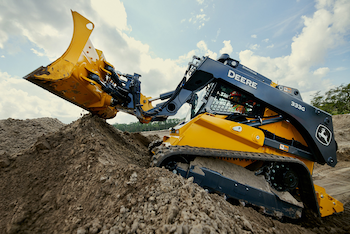 |
| John Deere developed the 333G SmartGrade compact track loader that fully integrates SmartGrade into the model and eliminates external masts and cables so grading tasks can be completed faster, in fewer passes and with less rework than machines without grade-control technology. |
While mechanical controls are still offered on machines, electro-hydraulic (EH) controls have been growing in popularity. John Deere’s large-frame machines come standard with EH ISO-pattern joystick controls and it is optional on other John Deere units.
Adding the EH joystick performance package adds maximum versatility. It allows the operator to choose between 4-way switchable controls (ISO, H-pattern, Foot, and ISO+Foot). The EH joystick performance package also pffers customizable settings such as switching accelerator/decelerator pedals and creep-control mode.
Understanding your customer’s needs and what applications they are working in is key in determining what skid steers and compact track loaders that should be in your fleet. The most common size class of machines in rental fleets are small- and mid-frame machines due to their reliability and low owning and operating costs. However, recently, there has been an increase in demand for large-frame machines.
One factor to help determine whether to add a skid steer vs. a compact track loader to your fleet is ground conditions. For applications that require lower ground pressure and/or better flotation, a tracked machine is probably your best option; if machines are going to be operating mostly on solid surfaces, then skid steers are a better option.
It’s important to consider what are the most popular attachments customers may be running and ensure that the machines in your fleet have the proper hydraulic flow to run them. Some of the most common attachments Deere sees going into rental fleets include buckets, pallet forks, augers, brooms and hammers or breakers. For customers looking at running multiple attachments, the John Deere’s Quik-Tach is a great feature to make switching between attachments easy.
When selecting units, ensure the machine is easy to service. Deere skid steers and compact track loaders are designed to be serviced quickly and efficiently, which allows you to quickly turn machines around after a rental. Daily service checkpoints, dipsticks, filters ,and fuel- and fluid-filler necks are easily accessible through the swing-out rear door. Deere machines also have extended service intervals; that keeps costs and downtime associated with regular maintenance low.
Configuring the machines in your fleet affects ROI. While John Deere offers many premium features, those may not be in demand in the rental industry. That’s why Deere offers skid steer and compact track loader packages ranging from very basic options up to premium features. Sticking toward the middle or lower end of these options will help ROI.
|
Blane Burroughs |
New units increase versatility
Kubota Tractor Corporation recently launched the newest member of its compact track loader line up, the SVL97-2. It incorporates many quality and feature upgrades making it a popular choiceamong users.
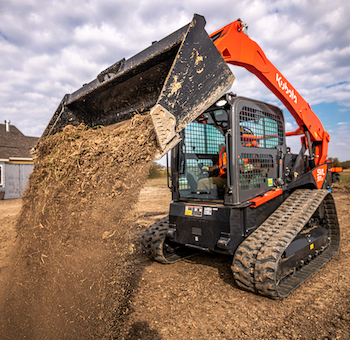 |
| Kubota Tractor Corporation recently launched the newest member of its compact track loader line up, the SVL97-2. It incorporates many quality and feature upgrades making it a popular choiceamong users. |
The SVL97-2 comes standard with a three-year subscription to KubotaNow telematics, a rearview camera and a lockable DEF door and fuel cap. These new standard features will benefit end users. Telematics will enable owners and operators to track their machines’ location, health and productivity from a distance. The rearview camera improves visibility, allowing end users to view more of their environment while on the job site. The lockable DEF door and lockable fuel cap, coupled with added signage, make it easier for operators to differentiate between the two types of fluid tanks.
Knowing the market in which you are competing is the most important factor for any business. We continue to see growth among professional contractors, but residential users/weekend warriors are outpacing the contractor’s growth rate.
A new skid steer or compact track loader in a rental fleet offers the ability of these machines to work in a many applications. Kubota offers more than 40 attachments for Kubota SSV65 and SSV75 skid steers. This gives rental centers the ability to target niche markets.
Telematics helps rental centers increase equipment ROI. Telematics gives rental centers a reliable way to track service and maintenance intervals, increasing the longevity of their investments.
Telematics can also alert rental centers when an error code is thrown on a machine. It enabling a staff member to act proactively by contacting customers, swapping out machines and keep customers working and reducing their downtime experience. A service tech can generate a snapshot of the machine’s operating conditions during the time of error for faster service and repairs, resulting in less machine downtime.
Another useful benefit of telematics is the ability to geofence a piece of equipment by creating a virtual perimeter in a geographical area. A rental center can create custom perimeters around its facilities and can be alerted when machines leave or enter the designated perimeter. This can reduce the risk of theft or simply provide accurate timelines when machines leave or enter the property for more accurate billing.
 |
| Jay Thaker Marketing manager Toro |
Battery-powered units show promise
Toro anticipates significant advances in technology in the skid steer loader (SSL), compact tool loader (CTL) and compact utility loaders (CUL) categories.
As the lines blur between SSL/CTL and CUL equipment, many of the same principles that apply to SSLs and CTLs also apply to CULs.
Toro engineers predict electric equipment in SSLs and CULs will become a bigger part of the industry. Battery-powered equipment is becoming more cost-effective while reducing or eliminating engine exhaust emissions and minimizing noise. The Toro e-Dingo 500 is a prime example of this. It allows customers to accomplish everything they need with battery power, with versatility, durability and zero engine exhaust emissions without sacrificing performance. Indoor demolition contractors are already seeing these benefits.
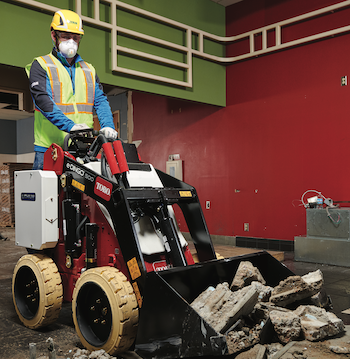 |
| Adding battery-powered SSLs/CTLs and CULs in rental fleets means rental stores will have more equipment options so that can be chosen for task at hand. |
Adding battery-powered SSLs/CTLs and CULs in rental fleets means rental stores will have more equipment options so that can be chosen for task at hand.
The CUL equipment class is evolving and filling some important gaps for rental customers. For example, the Toro Digno TXL 2000 offers comparable boom heights as SSL and CUL counterparts.
As rental centers expand into the battery-powered equipment space, the first upside is that customers can use equipment on indoor job sites. Further, the battery power is easy to recharge and eliminates the need to store back-up fuel on the job site.
There will still be a high demand for many classes of machines, including battery-powered equipment. This new technology is at the forefront of many customers’ minds as a problem solver. Rental stores can meet these needs and become the local go-to sources for battery-powered machines without sacrificing power or performance for their customers.
Savvy rental store owners with a pulse on the future can further strengthen their customer relationships by providing equipment that is a direct hit for several applications, which until this point, could not be solved with a standard gas-powered CUL or SSL.
 |
| Brett Newendorp Landscape Mkt. Mgr. Vermeer |
Trend to smaller models with greater capacity
There is a growing demand for smaller loaders in the rental market. Mini skid steers (compact utility loaders) fill this void in the rental market by offering a range of models from 500 to 1,600 pounds in lift capacity. The mini skid steer’s design allows operation on job sites where traditional units may not work.
In the last few years, manufacturers, including Vermeer, have introduced models with higher lift capacities and auxiliary hydraulic flow for attachments. These advances help bridge the gap between the skid steer/compact track loader and the mini skid steer product categories.
Many contractors choose to rent because they are looking for a specifically sized loader for the job site. It’s essential to have a wide range of loader sizes from which to choose; what’s the right size for one project may not on the next job.
 |
| To maximize the ROI and increase demand for mini or standard-sized skid steers, choose models that are easy to operate and designed for contractors. |
While mini skid steer loaders are growing in size and performance capabilities, not all larger models have the same footprint. To accommodate increasing lift capacities, some manufacturers expanded their machines’ width, which may not fit through a standard residential gate.
When designing the CTX160 mini skid steer, Vermeer took a different approach. This unit maintains a narrow profile while still lifting up to 1,600 pounds by slightly extending the machine’s length. This design honors the mini skid steer product segment’s qualities and complements the larger skid steer and compact track loaders most rental centers already have in their fleets.
To maximize the ROI and increase demand for mini or standard-sized skid steers, choose models that are easy to operate and designed for contractors. Professional contractors demand more from equipment, so select models that perform just as well after years of service as they did on the first rental. How well a machine is maintained is essential to getting the most from a machine as well as netting ROI. Ensuring that all manufacturer preventive maintenance is done correctly and having a dependable local dealer for additional support can help optimize the experience of the contractors renting a machine. Positive experiences result in repeat business and referrals.
This article appeared originally in the March-April 2021 issue of Pro Contractor Rentals magazine. ©2021 Urbain Communications LLC. All rights reserved.



